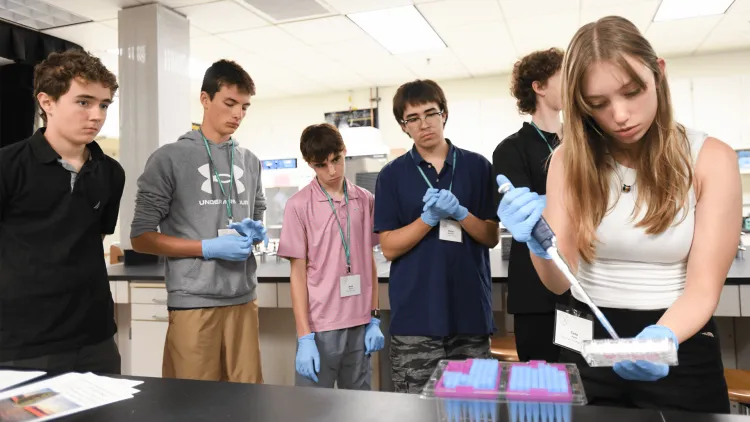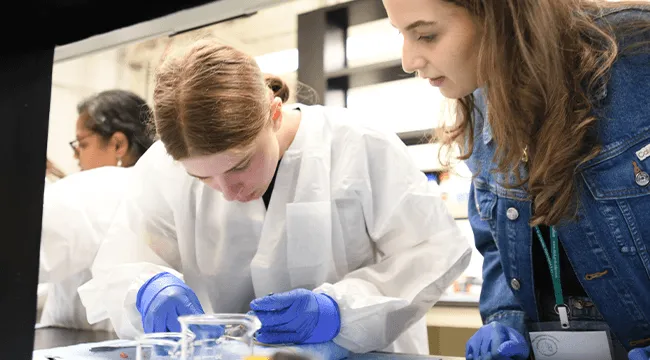This high school mentorship opportunity was offered at no charge to 26 high school students who are curious and motivated to explore cutting-edge bioengineering, biomedical research, and stem cell therapies in lung biology and disease. Applications were considered on a first-come, first-served basis.
The high school students joined about 150 local, national, and international researchers, industry representatives, graduate students, and postdoctoral fellows attending the 20th Anniversary Stem Cells, Cell Therapies, and Bioengineering in Lung Biology and Diseases conference at UVM. The conference took place July 7–10 in labs, classrooms, and at the Larner College of Medicine. This biennial conference is viewed by the National Institutes of Health, the U.S. Food and Drug Administration, and non-profit respiratory disease foundations as the major meeting worldwide to specifically focus on the role of stem cell therapies and bioengineering in lung disease. The researchers are leading experts in this field, coming to Vermont from research institutions across the globe.
The students learned about lung science and participated in leading-edge regenerative medicine techniques to treat lung diseases, including precision-cut lung slicing, using devices that measure respiratory biomechanics, and organoids—tiny, three-dimensional tissue cultures derived from stem cells. They heard from researchers about their career paths and mingled with undergraduate and graduate students, postdoctoral fellows, and junior and senior investigators who offered guidance, answered questions, and introduced them to the world of biomedical research.

“Our goal is to help young people learn about academic pathways in health science research and to give them the support and guidance they need to consider a biomedical research career,” says conference co-chair Daniel Weiss, M.D., Ph.D., professor of medicine at the Larner College of Medicine. “This is especially important for those who will be first-generation college students or live in areas where most people do not have access to these pathways.” Weiss adds, “Offering high school students an opportunity to become immersed in stem cell research and collaborate with expert researchers can serve as a powerful catalyst for their career aspirations.”
That’s exactly why Harwood Union High School student Cora Potts attended. “I want to explore career opportunities in the medical research field,” said Potts, who lives in Warren, Vermont. “I learned about gene editing in high school and I’ve been trying to follow any opportunity to learn more because this field is really interesting.”
“Having a broad representation of backgrounds and experience is beneficial to outcomes of research and the feeling of community.” — Julia Ormerod, biomedical engineering Ph.D. student
U-32 High School student James Churchill of Middlesex, Vermont, sat with Grace Spatafora, Ph.D., distinguished professor of pre-medical sciences at Middlebury College and president of the Vermont Academy of Science and Engineering, to ask about her research in microbial genetics and dental caries. In answering Churchill’s questions, Spatafora explained that stem cells allow humans to generate adult teeth after their baby teeth fall out, and how scientists are exploring this process for the possibility of regenerating adult teeth.
“Scientists are so excited and passionate about what they research. They were willing to share with everyone and made me feel like I belonged there,” Churchill said. “My biggest takeaway about stem cells was probably the idea of ‘niches,’ which are the specific conditions in which a stem cell is informed of what it’s supposed to be.” The conference sparked a particular interest because Churchill has a family member with cystic fibrosis, a life-shortening condition affecting the lungs.

Blaise Mackenzie of East Montpelier, Vermont, attended on the recommendation of the AP Physics teacher at U-32 High School, to explore careers in medical research. “I don’t see myself working directly with patients, but behind the scenes solving problems, figuring out what makes things happen and how to apply stem cell therapies in lung diseases,” Mackenzie said.
For Julia Ormerod, a biomedical engineering Ph.D. student who works in the Daniel Weiss Pulmonary Research Lab, the conference provided an opportunity to meet other graduate and undergraduate students in this field, create relationships, and serve as a mentor.
“High school students are trying to make decisions about where their careers are going, and that’s hard at 17 and 18 years old. I had mentors in high school, and it helped me decide to be an engineer,” said Ormerod, adding that she is pleased to see so many females attending the conference. “When I was in high school, I was surrounded by a majority of males interested in engineering. Having a broad representation of backgrounds and experience is beneficial to outcomes of research and the feeling of community.”
The first Stem Cells, Cell Therapies, and Bioengineering in Lung Biology and Diseases conference took place at UVM in 2005 under the leadership of Weiss, who has developed and published seminal work in stem cell–based therapies for lung diseases, including chronic obstructive pulmonary disorder, cystic fibrosis, and asthma.
